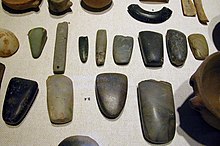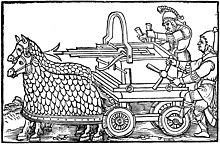Prehistoric weapons

Very simple weapon use has been seen in some communities of chimpanzees.[1], leading to speculation that early hominids may have first used weapons five million years ago.[2] but these would probably have been wooden clubs, spears and unshaped stones—none of which would leave an unambiguous record.
The earliest unambiguous examples of weapons are:
- Eight wooden throwing spears, the Schöninger Speere, which have been dated to around 400,000 years old.[3]
- By 250,000 years ago wooden spears were made with fire-hardened points[citation needed]
- The oldest atlatl dates back to 27,000 years ago[citation needed].
- Throwing sticks are also some of the earliest types of weapons.
[edit] Ancient and classical weapons

Ancient weapons were initially simply improvements of the late neolithic versions, but then significant improvement in materials and techniques created a series of revolutions in military technology:
The use of metal, first starting with copper during the Copper Age from about 3,300 BC, followed shortly by bronze led to the Bronze Age sword and other similar weapons.
The first defensive structures such as fortifications also appeared in the Bronze Age.[4] Weapons designed to be used against fortifications followed soon after: the battering ram was in use by 2500 BC [4]
Although the early Iron Age swords were not necessarily superior to their bronze predecessors, once iron-working developed - around 1200 BC in Sub-Saharan Africa[5], iron began to be used widely in weapons[6] because iron ore is much more common than the copper and tin required for bronze.
The domestication of the horse, and the widespread usage of the spoked wheel by ca. 2000 BC[7], led to the light, horse-drawn chariot. Chariots for use in battle were important in this era[citation needed]. The earliest spoke-wheeled chariots date to ca. 2000 BC and their usage peaked around 1300 BC, then declined, ceasing to have military importance by the 4th century BC[8].
Cavalry developed once horses were bred to support the weight of a man.
Purpose-built warships such as the Triremes were in use by the 7th century BC[9], eventually being replaced by larger ships by the 4th century BC.
[edit] Tactics and organization
As technology progressed, so did the level of organization of armies and empires. This led to the first professional armies which allowed aggressive, militaristic empires to develop.
While the early Greek armies focused on physical training, a key advance employed by the Roman army was the use of more complex tactics to gain additional advantage over their enemies.[10]

No comments:
Post a Comment